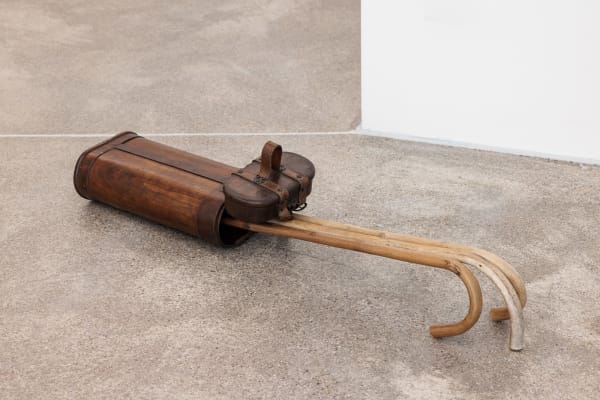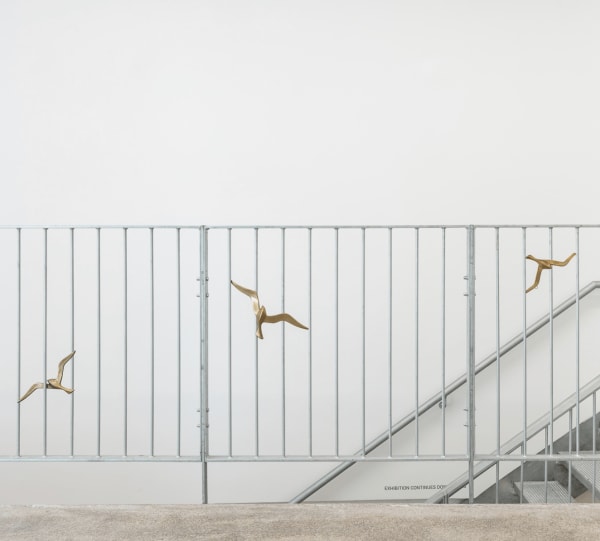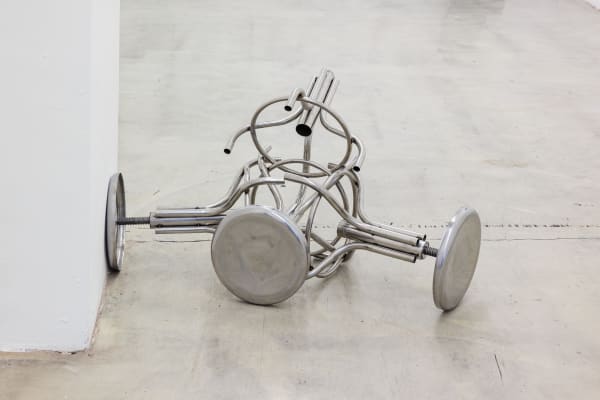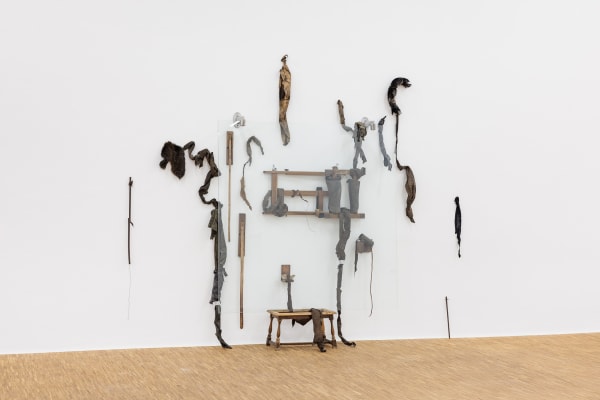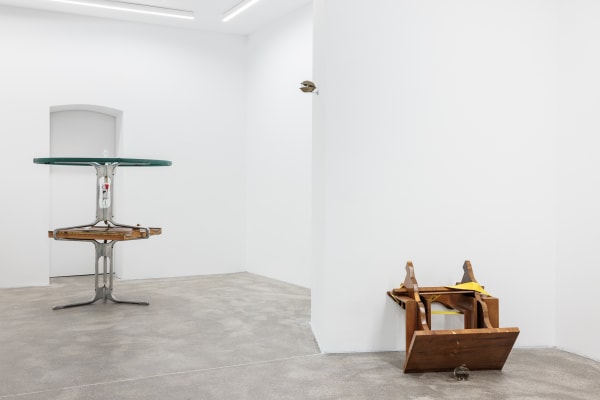Gleb Amankulov
Gleb Amankulov’s practice focuses on the working conditions of art production, in part including the precarious elements of this mode of living, whilst challenging the commercialization of artistic production and the fetishization of the art object in both the economic and artistic domains. The composition of the sculptures, perhaps better described as assemblages, are imbued with an ephemerality that is both physical and conceptual. In this regard, the works are created from found objects and ultimately left unchanged in their materiality. The artist does not weld, break or otherwise render obsolete the original purpose of the object. Beyond this, once the period of the exhibition is complete the sculptures are then disassembled. The majority of the objects are then re-sold or donated individually in their original state and corresponding economic value or repurposed for new sculptures. This practice ultimately questions the permanence of the art-object and the fluidity of the practice exists in opposition to economic and cultural power structures within artistic production.
Born in Minsk, Belarus, 1988
Lives and works in Vienna, Austria
EDUCATION
2022 Academy of Fine Arts, Vienna – Sculpture and Spatial Strategies, MA Fine Arts
(Prof. Monica Bonvicini; Prof. Iman Issa)
2013 Belarusian State Academy of Fine Arts, Minsk – Printmaking Department, BA
2007 College of Arts and Design, Minsk
SOLO EXHIBITIONS
2024 'Teilzeit in Senile Ties', COMMUNE, Vienna
2023 ‘In The Salt Storage’, Efes42, Linz, Austria
2022 ‘Stalagmite Eyes’ (2022), Academy of Fine Arts, Vienna
GROUP EXHIBITIONS
2024 ‘Debt’, curated by Hana Ostan-Ožbolt-Hass, Salzburger Kunstverein
2024 'Mirage’, curated by Cathrin Mayer, Kunstverein Braunschweig
2024 ‘Fragment I’, COMMUNE, Vienna
2023 ‘Spinning around oneself’, with Andreia Santana, curated by Hugo Canoilas, WAF Galerie, Vienna
2023 ‘Über das Neue’, Belvedere 21, Vienna
2023 ‘Identity Paradox’, Improper Walls, Vienna
2023 ‘Unfreezing The Scene’, Kunsthalle Wien Prize 2022’, Kunsthalle Wien, Vienna
2022 ‘Handeln im Jetzt’, Leopold Museum, Vienna
2022 ‘Separating Lines’, AG18 Gallery, Vienna
2022 ‘Three Course Menu’, Fffriedrich, Frankfurt
2022 ‘Ok, Regina’, Reginastrasse 16, Kassel
2021 ‘The Poiesis of Composting’, Xhibit, Vienna
2021 ‘CROP’, WAF Galerie, Vienna
2021 ‘Haus Wien’, Vienna
2021 ‘Oh Mini Golf!’ Kulturzentrum F23, Vienna ‘Becoming a Dog’, MUMOK Vienna
2021 ‘Secret Museum of Workers Movement’, Hoast, Vienna
2021 ‘G.E.L.’, Tanzqwartier Wien, Vienna
2020 ‘Exile Summer Camp’, Exile Gallery, Vienna
2020 ‘Haus & Freu(n)de’, Schweidlgasse 15/14, Vienna
2019 ‘WILD SPOERRI ROSENSTEIN’, Hotel am Brilliantengrund, Vienna
2019 ‘The Track of Time’, Periscope, Salzburg
AWARDS / SCHOLARSHIPS / FELLOWSHIPS
2024 Nominated for 'Belvedere Art Prize'
2023 ‘Arbeitsstipendium 2024’, City of Vienna
2023 ‘WHW Akademija Fellowship’, WHW, Zagreb
2022 ‘Academy Prize 2022’, Academy of Fine Arts, Vienna
2022 ‘Kunsthalle Prize’, Kunsthalle Wien, Vienna
2022 ‘Ö1 Talent Grant Shortlist’, ORF
2022 ‘Startstipendium bildende Kunst 2022’, BMKOE (2022)
-

Gleb Amankuov | Salzburger Kunstverein
Exhibition November 27, 2024DEBT 14 December 2024 – 16 February 2025 Curated By: Hana Ostan-Ožbolt-Haas Artists : Gleb Amankulov, Benjamin Hirte, David L. Johnson, Tammy Langhinrichs, Artur Schernthaner-Lourdesamy,...Read more -

Gleb Amankulov | Kunstverein Braunschweig
Exhibition November 26, 2024Mirage Curated by Cathrin Mayer Gleb Amankulov, Wisrah C. V. da R. Celestino, Kevin Jerome Everson and Philipp Fleischmann Dec 7, 2024 – Feb 23,...Read more -

Gleb Amankulov | Les Nouveaux Riches
Interview November 15, 2024Gleb AmankulovRead more
-

Gleb Amankulov
Teilzeit in Senile Ties 12 Sep - 25 Oct 2024Gleb Amankulov solo exhibition 'Teilzeit in Senile Ties'Read more -

Fragment I
Gleb Amankulov - Alexander Basil - Andi Fischer - Ani Gurashvili - Ni Hao - Choon Mi Kim - Jonida Laçi - Ty Locke - Mia Middleton- Vika Prokopaviciute 11 Apr - 17 May 2024Fragments is an ongoing group show concept separated in individual parts. This exhibition presents Fragment II. The artists are in no direct relation to each other within each Fragment. The...Read more




